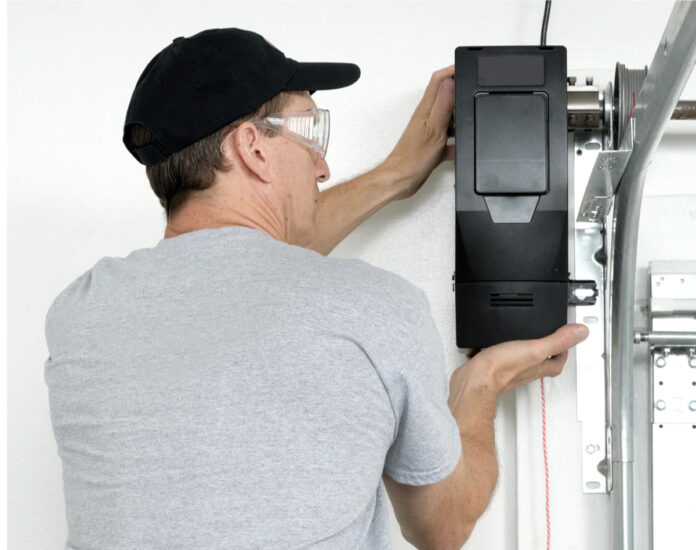Having a broken garage door is frustrating and inconvenient. It leaves your vehicles and belongings vulnerable if you can’t secure the garage. However, many common garage door issues can be fixed with basic DIY repairs before calling in a professional. In this post, we’ll cover some easy garage door repair techniques you can try yourself to save money and get your door functioning again quickly.
Check the Garage Door Opener
One of the most common causes of a garage door that won’t open is a faulty garage door opener. Start by inspecting the opener unit and power supply. Check that the power cord is securely plugged in and that there are no tripped circuit breakers. Make sure the emergency release cord or button is not engaged, which would prevent the opener from functioning. Also look for obstructions in the opener’s path like tools or boxes that may be preventing the door from moving freely. Clearing these can often resolve the problem without further repairs.
Lubricate the Tracks and Rollers
Over time, the metal tracks and wheels that your garage door rolls up and down on can become gritty and stuck. Applying lubricant to these moving parts is an easy way to get a squeaky or sticking door operating smoothly again. Remove any built-up dirt first by wiping the tracks and rollers with a clean rag. Then use a lubricant specifically made for garage doors, which you can find at most hardware stores. Spray or wipe it onto the tracks and where the rollers connect. This simple lubrication could be all that’s needed to fix a door that’s becoming difficult to open and close.
Adjust or Replace the Springs
The springs that help lift your heavy garage door are another component that can fail with age. There are two main types: extension springs run parallel to the sides of the door, while a torsion spring is at the top and helps balance the weight. If springs are broken or no longer holding tension, they will need to be repaired or replaced. However, you may be able to remedy a door that’s becoming harder to open by tightening extension springs yourself. Just be very careful, as springs under high tension can cause injury. Only attempt this if you’re confident in your abilities. Otherwise, call a pro for spring repairs.
Inspect and Adjust the Sensors
Photo eyes or sensors are safety features that detect objects below the closing door. If these become misaligned or dirty, your door may not close fully or reverse properly when something passes through the sensor beam. Clean the sensors with a soft cloth and check that they are positioned correctly according to the manufacturer’s specifications, usually around 4 inches above the floor. You can often adjust their angle slightly to remedy issues. Test that the sensors are triggering the door to stop and reverse as intended once cleaned and adjusted.
Replace or Tighten Loose Hardware
Over time, the screws, bolts, and other hardware connecting your garage door’s various moving parts may loosen due to vibration. Inspect all hinges, brackets, rollers, and other fittings for looseness. Tighten any bolts or nuts you find using the appropriate socket or wrench. You may also need to replace rusted or damaged garage door. Make sure all connections are snug to keep your door running smoothly without play or wobbling in the joints. Loose hardware is an easy fix that could solve strange noises or performance issues.
Inspect and Replace Cables as Needed
Steel cables running either side of the door are what connect the door panel to the opener above. With age and use, cables can fray or snap under tension. Check cables for rust, breaks, or loose connections at the drum end. Gently pull the cable to test for tension. If you notice any issues, cable replacement is recommended over further DIY repairs for safety. A cable failure could cause the heavy door to fall rapidly. Cable replacement is best left to experienced garage door technicians for this reason.
Balance the Door Properly
An unbalanced door that wants to drop or stick in the tracks is another sign of wear and tear. You may be able to remedy this yourself by adjusting the door’s counterbalance system. Loosen the lock nut holding the cable drum and rotate it slightly in one direction to add tension to that side as needed. Then retighten the nut and test the balance. Be very careful, as improper adjustment could cause the door to fall or become dangerous to operate. Only attempt this if you’re certain of the process. Otherwise, a pro can balance the door properly.
Consider Calling a Pro for Complex Issues
While many minor garage door problems can be addressed through basic DIY repairs, more serious or complex issues may require a professional. Signs it’s time to call in a technician include doors that suddenly won’t open or close at all, doors that are off their tracks, or recurring problems after attempting repairs. Richmond garage door companies like Integrity Garage Door Repair Service offers repairs, installations, and emergency services. Their technicians have the expertise, special tools, and heavy lifting equipment needed to fully diagnose and fix even major garage door breakdowns.
With a little know-how and basic tools, many homeowners can perform their own minor garage door maintenance and repairs. But complex issues are best left to the pros. By trying some DIY solutions first, you may be able to save the cost of a service call. Just be sure safety is the top priority when working on or around heavy moving garage doors. With regular care and timely repairs, your garage door system can provide reliable operation for many years to come.


